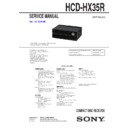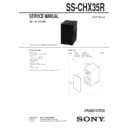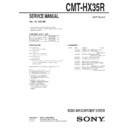Sony CMT-HX35R / HCD-HX35R Service Manual ▷ View online
SERVICE MANUAL
Sony Corporation
Audio&Video Business Group
Published by Sony Techno Create Corporation
HCD-HX35R
SPECIFICATIONS
COMPACT DISC RECEIVER
9-889-493-01
2009E05-1
©
2009.05
AEP Model
Ver. 1.0 2009.05
• HCD-HX35R is the amplifi er, USB, CD player
and tuner section in CMT-HX35R.
Model Name Using Similar Mechanism
HCD-HX50BTR
Base Unit Name
BU-K6BD90U-WOD
Optical Pick-up Name
KSM-213DCP
“WALKMAN” and “WALKMAN”
logo are registered trademarks of Sony
Corporation.
Corporation.
MPEG Layer-3 audio coding
technology and patents licensed from
Windows Media is a registered
in the United States and/or other
countries.
countries.
Fraunhofer IIS and Thomson.
trademark of Microsoft Corporation
Amplifier section
DIN power output (rated):
40 + 40 watts (6 ohms at 1 kHz, DIN)
Continuous RMS power output
(reference): 50 + 50 watts (6 ohms at
1 kHz, 10% THD)
Music power output (reference):
50 + 50 watts (6 ohms at 1 kHz, 10%
THD)
40 + 40 watts (6 ohms at 1 kHz, DIN)
Continuous RMS power output
(reference): 50 + 50 watts (6 ohms at
1 kHz, 10% THD)
Music power output (reference):
50 + 50 watts (6 ohms at 1 kHz, 10%
THD)
Inputs:
AUDIO IN (stereo mini jack):
voltage 250 mV, impedance
22 kilohms
voltage 250 mV, impedance
22 kilohms
(USB) port: Type A, maximum
current 500 mA
Outputs:
PHONES (stereo mini jack): accepts
headphones of 8 ohms or more
SPEAKER: accepts impedance of
6 ohms
headphones of 8 ohms or more
SPEAKER: accepts impedance of
6 ohms
USB section
Supported bit rate
MP3 (MPEG 1 Audio Layer-3):
32
32
320 kbps, VBR
WMA: 32
192 kbps, VBR
AAC: 48
320 kbps
Sampling frequencies
MP3 (MPEG 1 Audio Layer-3):
32/44.1/48 kHz
WMA: 44.1 kHz
AAC: 44.1 kHz
32/44.1/48 kHz
WMA: 44.1 kHz
AAC: 44.1 kHz
CD player section
System: Compact disc and digital audio
system
Laser Diode Properties
system
Laser Diode Properties
Emission Duration: Continuous
Laser Output*: Less than 44.6μW
Laser Output*: Less than 44.6μW
* This output is the value measurement
at a distance of 200mm from the
objective lens surface on the Optical
Pick-up Block with 7mm aperture.
objective lens surface on the Optical
Pick-up Block with 7mm aperture.
Frequency response: 20 Hz
20 kHz
Signal-to-noise ratio: More than 90 dB
Dynamic range: More than 90 dB
Dynamic range: More than 90 dB
Tuner section
FM stereo, FM/AM superheterodyne tuner
FM tuner section:
Tuning range:
87.5
108.0 MHz (50 kHz step)
Antenna: FM lead antenna
Antenna terminals: 75 ohms unbalanced
Intermediate frequency: 10.7 MHz
Antenna terminals: 75 ohms unbalanced
Intermediate frequency: 10.7 MHz
AM tuner section:
Tuning range:
531
1,602 kHz (with 9 kHz tuning
interval)
Antenna: AM loop antenna, external
antenna terminal
Intermediate frequency: 450 kHz
antenna terminal
Intermediate frequency: 450 kHz
General
Power requirements:
220
240 V AC, 50/60 Hz
Power consumption: 40 watts
Dimensions (w/h/d) (excl. speakers):
Dimensions (w/h/d) (excl. speakers):
Approx. 305 × 116 × 226 mm
Mass (excl. speakers): Approx. 2.8 kg
Design and specifications are subject to
change without notice.
change without notice.
HCD-HX35R
2
1.
SERVICING NOTES
............................................. 3
2. DISASSEMBLY
2-1. Disassembly Flow ........................................................... 5
2-2. Panel (Top) Block ........................................................... 6
2-3. Panel (Front) Block ......................................................... 6
2-4. Knob Assy ....................................................................... 7
2-5. MAIN Board ................................................................... 7
2-6. Loading Mechanism Block ............................................. 8
2-7. Base Unit (BU-K6BD91UR2-WOD) ............................. 8
2-8. Belt .................................................................................. 9
2-9. OP Base Assy (KSM-213D) ........................................... 9
2-2. Panel (Top) Block ........................................................... 6
2-3. Panel (Front) Block ......................................................... 6
2-4. Knob Assy ....................................................................... 7
2-5. MAIN Board ................................................................... 7
2-6. Loading Mechanism Block ............................................. 8
2-7. Base Unit (BU-K6BD91UR2-WOD) ............................. 8
2-8. Belt .................................................................................. 9
2-9. OP Base Assy (KSM-213D) ........................................... 9
3.
TEST MODE
............................................................ 10
4.
ELECTRICAL CHECKS
...................................... 11
5. DIAGRAMS
5-1. Block Diagram - CD SERVO Section - .......................... 13
5-2. Block Diagram - TUNER, USB Section - ...................... 14
5-3. Block Diagram - AUDIO Section - ................................. 15
5-4. Block
5-2. Block Diagram - TUNER, USB Section - ...................... 14
5-3. Block Diagram - AUDIO Section - ................................. 15
5-4. Block
Diagram
- PANEL, POWER SUPPLY Section - ........................... 16
5-5. Printed Wiring Boards - CD Section - ............................ 18
5-6. Schematic Diagram - CD Board - ................................... 19
5-7. Printed Wiring Board - USB Board - .............................. 20
5-8. Schematic Diagram - USB Board - ................................. 21
5-9. Printed Wiring Board - MAIN Board - ........................... 22
5-10. Schematic Diagram - MAIN Section (1/3) - ................... 23
5-11. Schematic Diagram - MAIN Section (2/3) - ................... 24
5-12. Schematic Diagram - MAIN Section (3/3) - ................... 25
5-13. Printed Wiring Board - AMP Board - ............................. 26
5-14. Schematic Diagram - AMP Board - ................................ 27
5-15. Printed Wiring Boards - INPUT/OUTPUT Section - ..... 28
5-16. Schematic Diagram - INPUT/OUTPUT Section - .......... 29
5-17. Printed Wiring Boards - PANEL Section - ..................... 30
5-18. Schematic Diagram - PANEL Section - .......................... 31
5-19. Printed Wiring Board - SW POWER Board - ................. 32
5-20. Schematic Diagram - SW POWER Board - ................... 33
5-6. Schematic Diagram - CD Board - ................................... 19
5-7. Printed Wiring Board - USB Board - .............................. 20
5-8. Schematic Diagram - USB Board - ................................. 21
5-9. Printed Wiring Board - MAIN Board - ........................... 22
5-10. Schematic Diagram - MAIN Section (1/3) - ................... 23
5-11. Schematic Diagram - MAIN Section (2/3) - ................... 24
5-12. Schematic Diagram - MAIN Section (3/3) - ................... 25
5-13. Printed Wiring Board - AMP Board - ............................. 26
5-14. Schematic Diagram - AMP Board - ................................ 27
5-15. Printed Wiring Boards - INPUT/OUTPUT Section - ..... 28
5-16. Schematic Diagram - INPUT/OUTPUT Section - .......... 29
5-17. Printed Wiring Boards - PANEL Section - ..................... 30
5-18. Schematic Diagram - PANEL Section - .......................... 31
5-19. Printed Wiring Board - SW POWER Board - ................. 32
5-20. Schematic Diagram - SW POWER Board - ................... 33
6.
EXPLODED VIEWS
6-1. Panel (Top) Section ......................................................... 47
6-2. Panel (Front) Section ...................................................... 48
6-3. Main
6-2. Panel (Front) Section ...................................................... 48
6-3. Main
Section
................................................................... 49
6-4. Chassis
Section
............................................................... 50
6-5. Loading Mechanism Section .......................................... 51
6-6. Base Unit Section (BU-K6BD91UR2-WOD) ................ 52
6-6. Base Unit Section (BU-K6BD91UR2-WOD) ................ 52
7.
ELECTRICAL PARTS LIST
.............................. 53
TABLE OF CONTENTS
NOTES ON CHIP COMPONENT REPLACEMENT
•
•
Never reuse a disconnected chip component.
•
Notice that the minus side of a tantalum capacitor may be dam-
aged by heat.
aged by heat.
FLEXIBLE CIRCUIT BOARD REPAIRING
•
•
Keep the temperature of soldering iron around 270 °C during
repairing.
repairing.
•
Do not touch the soldering iron on the same conductor of the
circuit board (within 3 times).
circuit board (within 3 times).
•
Be careful not to apply force on the conductor when soldering
or unsoldering.
or unsoldering.
SAFETY-RELATED COMPONENT WARNING!
COMPONENTS IDENTIFIED BY MARK
0 OR DOTTED LINE
WITH MARK
0 ON THE SCHEMATIC DIAGRAMS AND IN
THE PARTS LIST ARE CRITICAL TO SAFE OPERATION.
REPLACE THESE COMPONENTS WITH SONY PARTS
REPLACE THESE COMPONENTS WITH SONY PARTS
WHOSE PART NUMBERS APPEAR AS SHOWN IN THIS
MANUAL OR IN SUPPLEMENTS PUBLISHED BY SONY.
MANUAL OR IN SUPPLEMENTS PUBLISHED BY SONY.
This appliance is classified as a CLASS 1
LASER product. This marking is located
on the rear exterior.
LASER product. This marking is located
on the rear exterior.
CAUTION
Use of controls or adjustments or performance of procedures
other than those specifi ed herein may result in hazardous radia-
tion exposure.
Use of controls or adjustments or performance of procedures
other than those specifi ed herein may result in hazardous radia-
tion exposure.
HCD-HX35R
3
SECTION 1
SERVICING NOTES
UNLEADED SOLDER
Boards requiring use of unleaded solder are printed with the lead-
free mark (LF) indicating the solder contains no lead.
(Caution: Some printed circuit boards may not come printed with
Boards requiring use of unleaded solder are printed with the lead-
free mark (LF) indicating the solder contains no lead.
(Caution: Some printed circuit boards may not come printed with
the lead free mark due to their particular size)
: LEAD FREE MARK
Unleaded solder has the following characteristics.
• Unleaded solder melts at a temperature about 40 °C higher
• Unleaded solder melts at a temperature about 40 °C higher
than ordinary solder.
Ordinary soldering irons can be used but the iron tip has to be
applied to the solder joint for a slightly longer time.
applied to the solder joint for a slightly longer time.
Soldering irons using a temperature regulator should be set to
about 350 °C.
Caution: The printed pattern (copper foil) may peel away if
about 350 °C.
Caution: The printed pattern (copper foil) may peel away if
the heated tip is applied for too long, so be careful!
• Strong
viscosity
Unleaded solder is more viscous (sticky, less prone to fl ow)
than ordinary solder so use caution not to let solder bridges
occur such as on IC pins, etc.
than ordinary solder so use caution not to let solder bridges
occur such as on IC pins, etc.
• Usable with ordinary solder
It is best to use only unleaded solder but unleaded solder may
also be added to ordinary solder.
also be added to ordinary solder.
NOTES ON HANDLING THE OPTICAL PICK-UP
BLOCK OR BASE UNIT
BLOCK OR BASE UNIT
The laser diode in the optical pick-up block may suffer electro-
static break-down because of the potential difference generated by
the charged electrostatic load, etc. on clothing and the human body.
During repair, pay attention to electrostatic break-down and also
use the procedure in the printed matter which is included in the
repair parts.
The fl exible board is easily damaged and should be handled with
care.
static break-down because of the potential difference generated by
the charged electrostatic load, etc. on clothing and the human body.
During repair, pay attention to electrostatic break-down and also
use the procedure in the printed matter which is included in the
repair parts.
The fl exible board is easily damaged and should be handled with
care.
NOTES ON LASER DIODE EMISSION CHECK
The laser beam on this model is concentrated so as to be focused
on the disc refl ective surface by the objective lens in the optical
pickup block. Therefore, when checking the laser diode emission,
observe from more than 30 cm away from the objective lens.
The laser beam on this model is concentrated so as to be focused
on the disc refl ective surface by the objective lens in the optical
pickup block. Therefore, when checking the laser diode emission,
observe from more than 30 cm away from the objective lens.
RELEASING THE ANTITHEFT LOCK
The disc tray lock function for the antitheft of an demonstration
disc in the store is equipped.
The disc tray lock function for the antitheft of an demonstration
disc in the store is equipped.
Releasing Procedure:
1. Press the [
1. Press the [
?/1
] button to turn the power on.
2. While pressing the [
x
CANCEL] button, press the [
Z
] but-
ton unit “UNLOCKED” displayed on the fl uorescent indicator
tube (around 5 seconds) .
tube (around 5 seconds) .
Note: When “LOCKED”is displayed, the tray lock is not released by turn-
ing power on/off with the [
?/1] button.
HCD-HX35R
4
HOW TO OPEN THE TRAY WHEN POWER SWITCH TURN OFF
ATTENTION WHEN INSTALLING Q12
2
Make a small hole in the location
of the figure.
1
Remove the panel (side R).
(Illustration of disassembly is omitted.)
chassis (main)
panel (front) block
3
Insert the driver.
4
Push the lever.
5
Open the tray.
– chassis (main) side R view –
12 mm
12 mm
Note 2: Open more than 5 mm of screw (BVTP3x8)
installing Q12 in heatsink (REG)
to a chassis (main) from a screw point.
more than 5 mm
Q12
Note 1: Be sure to use an original screw
(Part No. 7-685-646-79 SCREW +BVTP 3X8 TYPE2 IT-3),
never use a screw longer than an original screw.
Q12
screw (BVTP3x8)
chassis (main)
chassis (main)
panel (back)
SW POWER board
SW POWER board
heatsink (REG)



